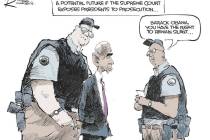What does officer’s tattoo really mean?
An interesting five-part Review-Journal series last week on fatal shootings by local police.
We get letters, asserting "I'm not afraid of ever getting shot by a Metro cop because I would never disobey a policeman's orders, and I would never be foolish enough to point a weapon at an officer."
When did we reach the point where it's a capital offense to decline to obey any policeman's order? How about if the policeman is demanding oral sex? It's happened.
Besides, what weapon did Orlando Barlow -- surrounded by armed cops, kneeling in a front yard with his hands on his head -- point at anyone to deserve being shot by officer Brian Hartman in February 2003? One of his elbows?
Hartman said he shot Barlow because the man "made a furtive movement."
After Hartman and his buddies printed up T-shirts with an image of his AR-15 on them, identifying the squad that took out Barlow as the "Baby's Daddy Removal Team," Metro broke up that group, the Review-Journal series reported. An ineffective lieutenant and sergeant were transferred and/or demoted. Hartman and two other officers are no longer on the force.
That's good news. So why does Metro remain such an insulated world that the public was never before officially told of those changes?
Not that problems don't remain. Take officer Rodolfo Gil. A Metro source said Gil, who has used deadly force against two suspects in his career, commemorated his killings with a tattoo and had set a single-officer record for Internal Affairs complaints, which can range from demonstrating a surly attitude to excessive use of force.
Gil told a Metro public information officer on Nov. 23 that he had no interest in talking to me. But Clark County Sheriff Doug Gillespie was willing to talk.
For the record, I believe Gil's two fatal shootings were completely justified. In January 2006, fleeing suspect Edgar Doubleday, 47, high on methamphetamine and prescription drugs, fired on Gil, at that time a seven-year veteran. Gil "became one with the sidewalk," as one fellow officer put it, and returned fire -- effectively. Six months later, domestic violence suspect Shawn Jacob Collins, 43, high on alcohol, cocaine and prescription drugs, pointed his gun at Gil and other officers at a local convenience store and was shot to death.
If the story ended there, Rodolfo Gil might be a courageous cop to be proud of.
I asked the sheriff about Gil's upper arm tattoo. The Metro source said it's a flaming skull and crossbones, with a pair of dice underneath bearing the dates of his kills.
"He has the tattoo, but it does not have the dates," Sheriff Gillespie told me last week, after checking. "From what I'm being told, he has had it for a couple of years, and he has been talked to about tattoos and the appropriateness of them."
There are no dice, the sheriff explained. "It actually has, like, two bullets ... not the bullets themselves, but they are bullet casings. ... It's a part of his body that's covered by clothing and wouldn't be seen at work. When asked about it, he says it signifies an important event in his life.
"If it had the dates it would be much more of a concern to me, even if it was covered. If we were involved in any kind of litigation it could put us in a situation, from a lack of sensitivity standpoint, that wouldn't (cast) a favorable light on us as an organization. ...
"Tattoos are private," Sheriff Gillespie went on. "We are in an area there where we can't mandate what people tattoo or don't. Based on feedback from the people who work closely with him ... there are no dates."
I went back to my source.
"I saw them; the dates were there." And then, "This guy was number one on IAB's (Internal Affairs Bureau) complaint list. They pulled him off patrol for a while, and as his punishment they had him sitting there taking the complaint calls. To me, this is one officer who really shouldn't even be out there carrying a gun. If any officer needs a suitability hearing, he's it. And the creepy thing is, for a time Gil was a field training officer. He trained new recruits."
I talked to Sheriff Gillespie again on Wednesday.
"Because of the number of complaints that he had, yes, he was assigned to Internal Affairs as a ride-along status, riding along to see ... what it is about an officer's conduct that generates complaints. We did this as a way to better educate some of our employees on how to interact with the public." During that 30 days "Yes, he was answering phones during that time, taking complaint calls." And yes, Gil was a field training officer at one point. No more.
Back to the tattoo: Does it commemorate the two shooting deaths?
"He didn't say that, but I think the inference could be drawn because of what the tattoo depicts," the sheriff said. "His captain talked to him about how the tattoo could ... cast doubts on his professionalism. ... In any litigation, anything has the potential to be brought in ... that would tend to show the attitudes of the officers. But we have due process. In this case, with officer Gil ... he has due process rights."
"Under the union contract, you mean?" I asked.
The sheriff indicated agreement.
"Something that shocks the conscience doesn't necessarily rise to the level of termination," the sheriff said.
Vin Suprynowicz is assistant editorial page editor of the daily Las Vegas Review-Journal, and author of "The Black Arrow" and "Send in the Waco Killers." See www.vinsuprynowicz.com.























